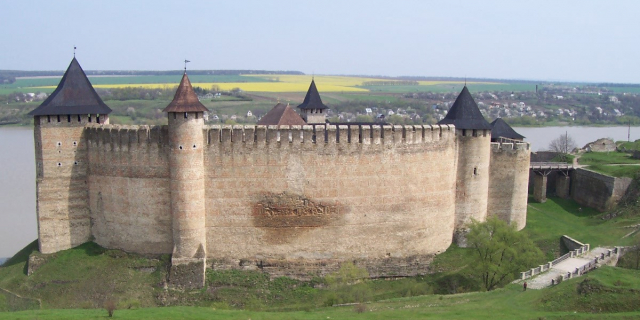Kamianets-Podilskyi Castle (Ukrainian: Кам'янець-Подільська фортеця; Polish: twierdza w Kamieńcu Podolskim; Lithuanian: Podolės Kameneco tvirtovė) is a former Ruthenian-Lithuanian castle and a later three-part Polish fortress located in the historic city of Kamianets-Podilskyi, Ukraine, in the historic region of Podolia in the western part of the country. Its name is attributed to the root word 'kamin', from the Slavic word for 'stone'.
Historical accounts date Kamianets-Podilskyi Castle to the early 14th century, although recent archaeological evidence has proved human existence in the area back to the 12th or 13th century. Initially built to protect the bridge connecting the city with the mainland, the castle sits on top of a peninsula carved out by the winding Smotrych River, forming a natural defense system for Kamianets-Podilskyi's historic Old Town neighborhood.
I...Read more
Kamianets-Podilskyi Castle (Ukrainian: Кам'янець-Подільська фортеця; Polish: twierdza w Kamieńcu Podolskim; Lithuanian: Podolės Kameneco tvirtovė) is a former Ruthenian-Lithuanian castle and a later three-part Polish fortress located in the historic city of Kamianets-Podilskyi, Ukraine, in the historic region of Podolia in the western part of the country. Its name is attributed to the root word 'kamin', from the Slavic word for 'stone'.
Historical accounts date Kamianets-Podilskyi Castle to the early 14th century, although recent archaeological evidence has proved human existence in the area back to the 12th or 13th century. Initially built to protect the bridge connecting the city with the mainland, the castle sits on top of a peninsula carved out by the winding Smotrych River, forming a natural defense system for Kamianets-Podilskyi's historic Old Town neighborhood.
Its location on a strategic transport crossroad in Podolia made the castle a prime target for foreign invaders, who rebuilt the castle to suit their own needs, adding to its multicultural architectural diversity. Specifically, the complex consists of the Old Town fortified by King Casimir IV, the Old Castle rebuilt by Kings Sigismund I and Stephen Báthory, and the New Castle founded by Kings Sigismund III and Władysław IV. However, in spite of the many architectural and engineering changes to the original structure, the castle still forms a coherent architectural design, being one of the few medieval constructions in modern-day Ukraine that is relatively well preserved.
Along with the Old Town neighborhood, the castle is listed as part of the National Historical-Architectural Reserve "Kamianets" and the National Environmental Park "Podilski Tovtry". The complex is a candidate UNESCO World Heritage Site, nominated in 1989 by the Ukrainian representatives, and also one of the Seven Wonders of Ukraine. Today, Kamianets-Podilskyi Castle is the most recognized landmark of the city, serving as an important regional and national tourist attraction.
 A 1691 French-language map depicting the Kamianets Old Town neighborhood and castle
A 1691 French-language map depicting the Kamianets Old Town neighborhood and castleTraditionally, Kamianets-Podilskyi Castle was thought to have been founded during the second half of the 14th century, as the first accurate historical accounts of the castle date back to the mid-14th century, when most of the territories of western Rus' were under control of the Grand Duchy of Lithuania.[1] A written document by Prince Yuriy Koriatovych in 1374, for example, mentions that the Magdeburg rights would be presented to Kamianets inside the castle.[2] Archaeological excavations during the 1960s, however, provided contrasting evidence suggesting that the castle might date back even earlier to the end of the 12th or the beginning of the 13th centuries.[3] It is also clear from historical and archaeological evidence that an earthen fortress existed in the area during the time of the East Slavic state of Kievan Rus', but not on the same site as the current castle.[4]
The castle was outdated but remained vital to the defense of Kamianets and nearby trade routes; as a result, the voivode of Kraków, Spytek of Melsztyn, began modernizing the complex at the turn of the 15th century.[5] During the reconstruction, the old towers were renovated and ten new towers were added. A century and a half later, the castle was updated again, this time by military engineer and architect Hiob Bretfus, who built the New Western and Eastern Towers, the castle's eastern wall and an underground gallery, as well as the Full Gates and housing for the town's starosta community.[6][nb 1]
Continuous attacks by invaders An old lithograph depicting the castle walls with a settlement underneath, which still exists today
An old lithograph depicting the castle walls with a settlement underneath, which still exists todayDuring the mid-14th to mid-15th centuries, Kamianets-Podilskyi Castle was located on one of the main frontiers of the Polish–Lithuanian Commonwealth. From 1434 until its annexation by the Russian Empire in 1793, the castle played a major role in the defense against the oncoming Cossack, Ottoman, and Tatar invasions; from the 15th through 17th centuries, the castle was attacked by Tatar hordes a total of 51 times.[7] The Tatar invasions of 1448, 1451, 1509, and 1528, as well as the Ottoman siege of 1533, caused damage to both the castle and the city but all of these invasions were successfully repelled.[7]
Kamianets-Podilskyi Castle played an important role during the Khmelnytsky Uprising between 1648 and 1654, when the Zaporozhian Cossacks led by Hetman Bohdan Khmelnytsky, allied themselves with the Crimean Tatars and the local Ukrainian peasantry against the Polish–Lithuanian Commonwealth's army and militia. During the uprising, the castle was unsuccessfully besieged by local Cossacks and insurgents led by Commander Maksym Kryvonis.[7] In 1651, the castle was then subject to another Cossack siege led by Hetman Ivan Bohun, before an unexpected counterattack by Polish insurgents under commanders Aleksandrenka and Chuika re-established the Polish presence in the area and relieved the siege. A 60,000 force army led by Khmelnytsky himself reasserted Cossack control over the castle in 1652.[7] Just one year later, the castle was attacked yet again, this time by a 40,000 strong Crimean Tatar horde.[7]
 Ustym Karmaliuk. Vasily Tropinin, c. 1820s oil on canvas. State Tretyakov Gallery, Moscow.
Ustym Karmaliuk. Vasily Tropinin, c. 1820s oil on canvas. State Tretyakov Gallery, Moscow.In the beginning of August 1672, a 300,000 Ottoman force led by Sultan Mehmed IV and a 40,000 combined force of Tatars and Cossacks led by Hetman Petro Doroshenko laid siege to the castle.[7] After conducting negotiations with their attackers, the city's leaders surrendered control of the fortress to the Ottomans on August 18. In a sign of protest, the fortress's Commandant Michał Wołodyjowski and Major Ketling blew up the castle's remaining gunpowder, killing themselves along with 800 defenders.[7] For 27 years after the attack, the fortress served as the base of Ottoman rule in Podolia.[7] The 1699 Karlov Peace Treaty saw the return of Polish control over the area after the Ottoman Empire ceded its control in the area.[1]
From a castle to a prisonFrom the beginning of the 18th century, Kamianets-Podilskyi Castle had lost its defensive role, and was used more as a military prison than a military fortification.[6][7] Numerous people were executed or held captive in the prison, including Cossack starshynas (officers), haidamakas,[nb 2] and even the three-year-old pretender to the Polish throne, Stanisław August Poniatowski.[7]
Even though it had lost its defensive role, it was one of the strongest fortresses in the Crown of the Kingdom of Poland up until the Second Partition of Poland of April 21, 1793.[8][9][10] when both Kamianets-Podilskyi Castle and the city were transferred to the sovereignty of the Russian Empire. On the same day, the castle's commandant gave up the key to the castle and swore allegiance to the empire in the city's cathedral.[7] One hundred and one artillery cannons later saluted the commandant's decision inside the castle.[7] During the French invasion of Russia of 1812, the Russian Imperial Army was stationed in the castle. In 1815, Konstantin Batyushkov, who later became a well-known poet and writer, was stationed as an officer in the castle.[7] In 1846, poet Vladimir Raevsky was stationed in the castle, during which time he established a pro-Decembrist organization of progressively-minded army officers.[7]
From 1816 until 1914, the fortress was converted from a military prison into a jail for debtors, criminals and political prisoners.[11] In 1831, Russian lexicologist Vladimir Dal worked in the castle, at the time writing a dictionary of the Russian language.[5] The castle was the center of the anti-feudalism movement in the Podolia during the 19th century led by the Patriotic War of 1812 cavalry veteran Ustym Karmaliuk (1787–1835), who is now regarded by Ukrainians as a national folk hero.[12][13]
Museum and conservation Interior courtyard and view of the castle's museum
Interior courtyard and view of the castle's museumAfter a series of political changes following the 1905 revolution, political parties and organizations were allowed by the law throughout the Russian Empire. In 1906, a total of 67 political organizations were based in the castle. Among them was the Russian Social Democratic Labour Party's newspaper "Iskra" (Spark).[14] A decree issued by the Sovnarkom of the Ukrainian Soviet Socialist Republic in 1928 declared Kamianets-Podilskyi Castle complex a historical-cultural preserve.[15] During the late 1930s, plans were made to turn the castle into a museum, and reconstruction work on the buildings was started in 1937.[15] Among the museum attractions added was a scene depicting Karmaliuk in the castle's prison cell in the Pope's Tower, where he was kept during his imprisonment in the castle. Visitor numbers for the castle during the 1930s reached 300,000 a year.[7]
In 1947, Kamianets-Podilskyi Castle was placed on the all-Union list of historic preserves.[15] A memorial plaque and a bas-relief resembling Karmaliuk was erected near the Karmaliuk exposition on April 18, 1958.[7] Restorational and archaeological works have been conducted at the castle since 1962 under the supervision of architects Y. Plamenytska and A. Tyupych.[16] On May 18, 1977, the National Historic-Architectural Reserve "Kamianets" was established.[17] On September 13, 1989, the Ukrainian SSR Government placed "Kamianets" reserve on the tentative list of UNESCO World Heritage Sites.[18]
In 2004, the "Kamianets" reserve was upgraded to that of a national preservation district.[19] On August 21, 2007, the complex was declared one of the Seven Wonders of Ukraine when it came in 3rd place in a nationwide competition.[20] A severe storm on August 1, 2011, partially destroyed the New Western Tower; the city mayor's office didn't deny that the tower's structural integrity was weakened during its last reconstruction in 2007, paving the way for its collapse just four years later.[21]
Cite error: There are <ref group=nb> tags on this page, but the references will not show without a {{reflist|group=nb}} template (see the help page).




























Add new comment